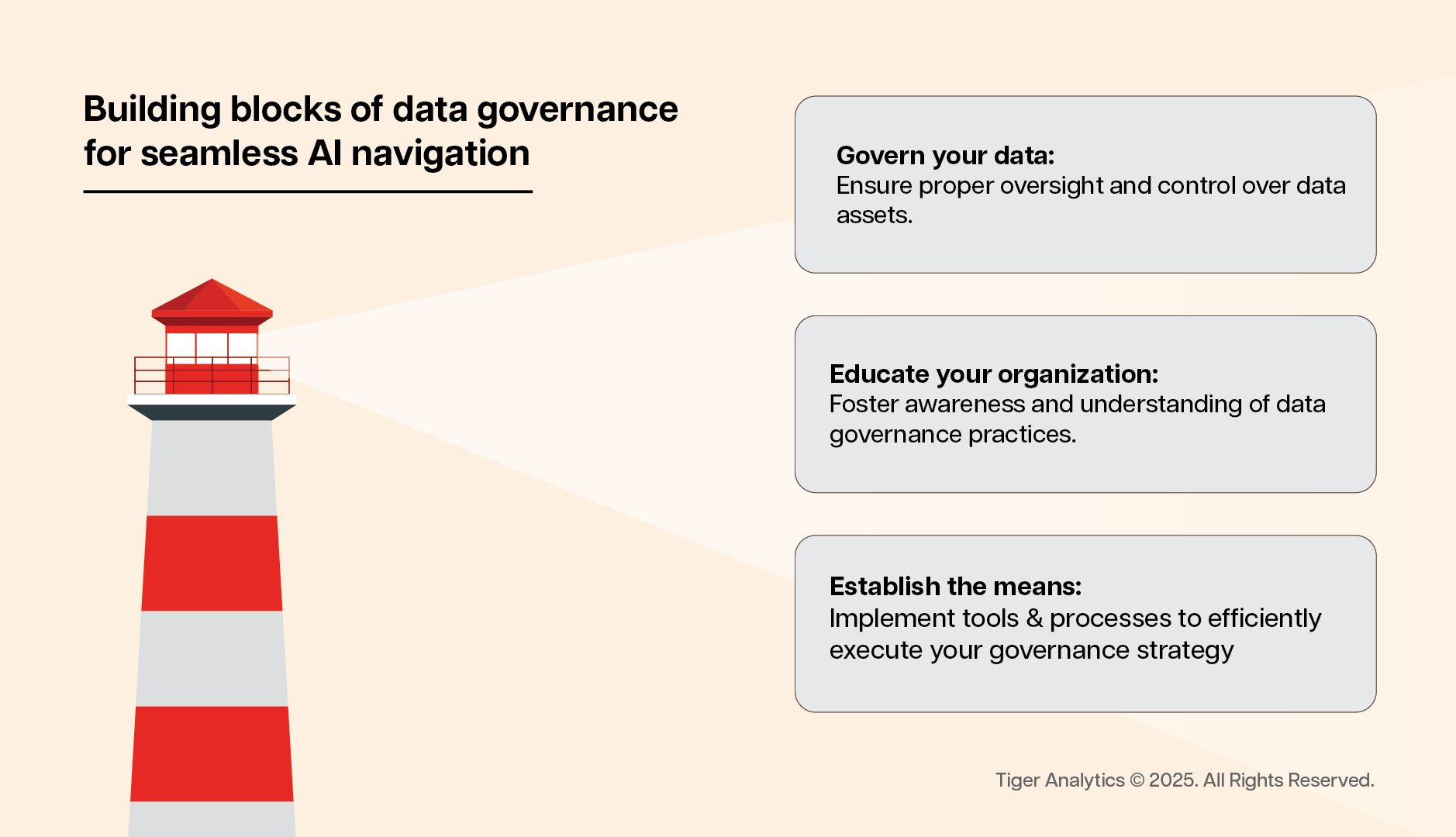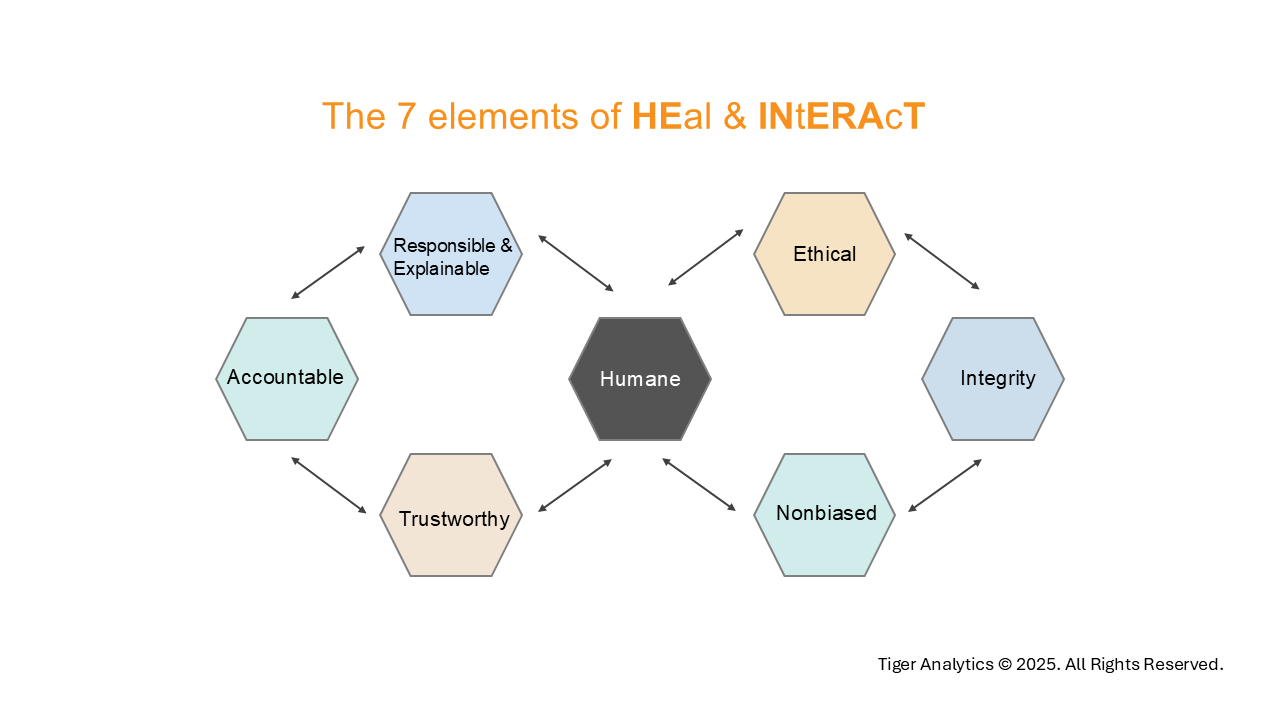In 1968, HAL 9000’s “I’m sorry, Dave. I’m afraid I can’t do that” marked the beginning of a new era in entertainment. As the years passed, films like 2004’s IRobot, and 2015’s Chappie continued to explore AI’s potential – from “One day they’ll have secrets… one day they’ll have dreams” to “I am consciousness. I am alive. I am Chappie.” While these fictional portrayals pushed the boundaries of our imagination, they also laid the groundwork for AI technologies such as self-driving cars, consumer personalizations, Generative AI and the like, that are shaping the world today.
Today, the rise of GenAI and copilots from various tool vendors and organizations has generated significant interest, driven by advancements in NLP, ML, computer vision, and other deep learning models. For CIOs, CDOs, and data leaders, this shift underscores a critical point: AI-powered technologies must be responsible, transparent, ensure privacy, and free of bias to truly add business value.
Since AI and GenAI both depend on data for fuel, it cements the need for the availability of the right data with the right quality, trust, and compliance. Without strong data governance, organizations risk AI models that reinforce bias, misinterpret data, or fail to meet regulatory requirements. This further underscores the importance of Data Governance as a critical discipline that serves as a guiding light.
Hence, ‘The lighthouse remains a beacon amidst shifting tides’ – In today’s context, this metaphor reflects the challenges faced by both data-driven and AI-driven enterprises. The landscape of data generation, usage, and transformation is constantly evolving, presenting new complexities for organizations to navigate. While data governance is not new, with many a change in weather (data) patterns and the infusion of AI across industries, it has grown increasingly relevant, acting as the foundation on which AI can be governed and enabled.

At Tiger Analytics, we are constantly exploring new opportunities to optimize the way we work. Take, for example, enterprises where time-to-market is critical, product vendors have developed copilots using GenAI. We have also observed many initiatives among our Fortune 100 clients leveraging models and various AI elements to achieve a faster time-to-market or develop new offerings. Many of these projects are successful, scalable, and continue to drive efficiency. However, the inevitable question arises: How do we govern AI?
What are the biggest challenges in Data Governance – Answering key questions
Data governance is not just about compliance — it is essential to enhance data quality and trustworthiness, efficiency, scalability, and produce better AI outcomes. Strong governance practices (process, op model, R&R) empower enterprises to unlock the full potential of their data assets.
Below are a few important questions that stakeholders across the enterprise, including CxOs, business leaders, Line of Business (LoB) owners, and data owners, are seeking to answer today. As organizations strive towards data literacy and ethical AI practices, these questions highlight the importance of implementing governance strategies that can support both traditional data management and emerging AI risks.
- Who is in charge of the model or the data product that uses my model?
- Who can control (modify/delete/archive) the dataset?
- Who will decide how to control the data and make key decisions?
- Who will decide what is to be controlled in the workflow or data product or model that my data is part of?
- What are the risks to the end outcome if intelligence is augmented without audits or controls, or quality assurance?
- Are controls for AI different from current ones or can existing ones be repurposed?
- Which framework will guide me?
- Is the enterprise data governance initiative flexible to accommodate my AI risks and related work?
- With my organization in the process of becoming data literate and ensuring data ethics, how can AI initiatives take advantage of the same?
- Is user consent still valid in the new AI model, and how is it protected?
- What are the privacy issues to be addressed?
Let’s consider an example. A forecasting model is designed to help predict seasonal sales to launch a new apparel range targeted at a specific customer segment within an existing market. Now, assume the data is to be sourced from your marketplace and there are readymade data products that can be used – How do you check the health of the data before you run a simulation? What if you face challenges such as ownership disputes, metadata inconsistencies, or data quality issues? Is there a risk of privacy breaches if, for example, someone forgets to remove sample data from the dataset?
This is why Data Governance (including data management) and AI must work in tandem, even more so when we consider the risk of non-compliance, for which the impact is far greater. Any governance approach must be closely aligned with data governance practices and effectively integrated into daily operations. There are various ways in which the larger industry and we at Tiger Analytics are addressing this. In the next section, we take a look at the key factors that can serve as the foundation for AI governance within an enterprise.
Untangling the AI knot: How to create a data governance framework for AI
At Tiger Analytics, we’ve identified seven elements that are crucial in establishing a framework for Foundational Governance for AI – we call it HEal & INtERAcT. We believe a human-centric and transparent approach is essential in governing AI assets. As AI continues to evolve and integrate into various processes within an organization, governance must remain simple.
Rather than introducing entirely new frameworks, our approach focuses on accessible AI governance in which existing data governance operations are expanded to include new dimensions, roles, processes, and standards. This creates a seamless extension rather than a separate entity, thereby eliminating the complexities of managing AI risks in silos and untangling the “AI knot” through smooth integration.

The seven elements ensure AI governance remains transparent and aligns with the larger enterprise data governance strategy, influencing processes, policies, standards, and change management. For instance, Integrity and Trustworthiness reinforce reliability in model outputs and help create a trustworthy output that ensures privacy, while Accountability and Responsibility establish clear ownership of AI-driven decisions, ensuring compliance and ethical oversight. As AI introduces new roles and responsibilities, governance frameworks are revised to cover emerging risks and complexities like cross-border data, global teams, mergers, and varying regulations.
In addition, the data lifecycle in any organization is dependent on data governance. AI cannot exist without enterprise data. Synthetic data can only mimic actual data and issues. Therefore, high-quality, fit-for-purpose data is essential to train AI models and GenAI for more accurate predictions and better content generation.
Getting started with AI governance
Here is how an enterprise can begin its AI governance journey:
- Identify all the AI elements and list out every app and area that uses it
- What does your AIOps look like, and how is it being governed?
- Identify key risks from stakeholders
- Map them back to the principles
- Define controls for the risks identified
- Align framework with your larger data governance strategy
- Enable specific processes for AI
- Set data standards for AI
- Tweak data policies for AI
- Include an AI glossary for Cataloging and Lineage, providing better context
- Data observability for AI to set up proactive detection for better model output and performance
Essentially, Enterprise DG+AI principles (framework) along with Identification & Mitigation strategies and Risk Controls, will pave the way for efficient AI governance. Given the evolving nature of this space, there is no one-size-fits-all solution. Numerous principles exist, but expert guidance and consulting are essential to navigate this complexity and implement the right approach.
The Road Ahead
AI has moved from science fiction to everyday reality, shaping decisions, operations, and personalized customer experiences. The focus now is on ensuring it is transparent, ethical, and well-governed. For this, AI and data governance must work in tandem. From customer churn analysis to loss prevention and identifying the right business and technical metrics, managing consent and privacy in the new era of AI regulations, AI can drive business value — but only when built on a foundation of strong data governance. A well-structured governance program ensures AI adoption is responsible and scalable, minimizing risks while maximizing impact. By applying the principles and addressing the key questions above, you can ensure a successful implementation, enabling your business to leverage AI for meaningful outcomes.
So while you ponder on these insights, ’til next time — just as the T800 said, “I’ll be back!”





